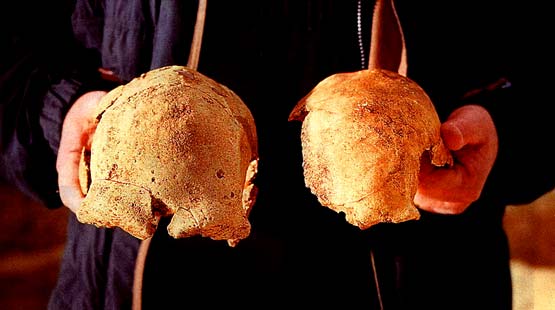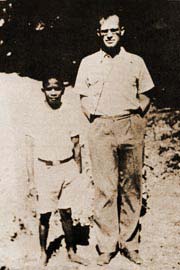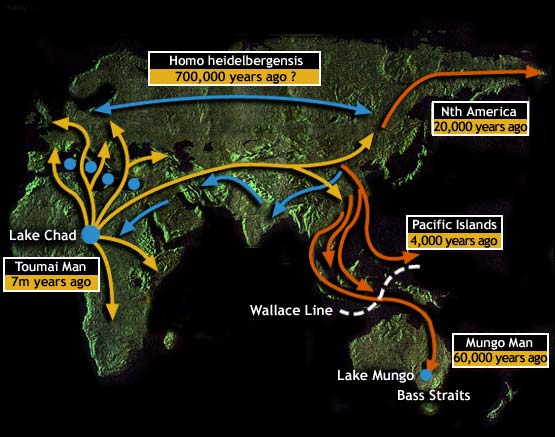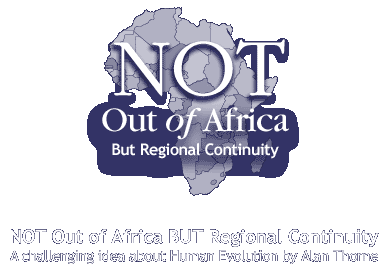 | |||||||||||||||||||||||||
| Mungo Lady was delivered to Alan Thorne in a small cheap suitcase in 1968 when he was 28 years old. Her burned and shattered bones were embedded in six blocks of calcified sand. The field researchers who dug her up in a parched no-man's-land in southeastern Australia suspected that she was tens of thousands of years old. | |||||||||||||||||||||||||
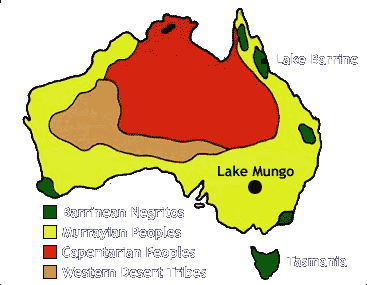 | |||||||||||||||||||||||||
| Almost every day for the next six months, he painstakingly freed her remains from the sand with a dental drill, prizing out more than 600 bone chips, each no larger than a thumbnail. He washed them carefully with acetic acid, sealed them with a preservative, and pieced them together into a recognisable skeleton. Looking closely at skull fragments, bits of arm bone, and a hint of pelvis, he became convinced that two things were true. First, the bones were human, Homo sapiens for sure, and they had held together a young woman. As he assembled this "monster three-dimensional jigsaw puzzle," Thorne, then a lecturer in the department of anatomy at the University of Sydney, began asking himself whose bones they might actually have been. He had no idea that many years later, the answer to that question would rock the world of anthropology. | |||||||||||||||||||||||||
| |||||||||||||||||||||||||
| Something else about this woman became clear early on she had been important and powerful. The pattern of burn marks on her bones showed that after she died, her family burned the corpse, then smashed the bones. Later they added more fuel and burned the bones a second time. This was an unusual ritual. Ancient Aboriginal women were typically buried without fuss. Thorne wondered if her descendants had tried to ensure that she did not return to haunt them. As hours and days and months passed, he found himself thinking of her as a living, breathing person who'd spent her life encamped on the shores of Lake Mungo, in New South Wales. If this Mungo Lady turned out to be as ancient as field researchers thought, she would be the oldest human fossil ever found in Australia. | |||||||||||||||||||||||||
| |||||||||||||||||||||||||
| That was an exotic thought, and now, many years later, it is fuelling the debate within anthropology over a single huge question: Where did Homo sapiens come from? Most researchers accept a theory referred to as "Out of Africa." It holds that numerous species of hominids beginning with Homo erectus began migrating out of Africa almost 2 million years ago and evolved into several species. Then a new species called Homo sapiens evolved in Africa and migrated between 100,000 and120,000 years ago to Europe, Asia, and Australia, consigning all the earlier hominids it encountered to extinction. Regional Continuity Thorne preaches a revolutionary view called Regional Continuity. He believes that the species his opponents insist on calling Homo erectus was in fact Homo sapiens, and that they migrated out of Africa almost 2 million years ago and dispersed throughout Europe and Asia. As he sees it, there was no later migration and replacement "Only one species of human has ever left Africa, and that is us" | |||||||||||||||||||||||||
| |||||||||||||||||||||||||
| Why does this matter? Because if Thorne and his camp are right, much of what we think we know about human evolution is wrong. In the world according to Thorne, the human family tree is not divided into discrete species such as Homo erectus, Homo antecessor, Homo heidelbergensis, and Homo neanderthalensis. They are all Homo sapiens. Thorne agrees, from the outside all these hominids look different from each other, but so do humans today a Korean, a Nigerian, and a Dane hardly resemble each other. Our ancestors displayed great variety, but they were similar in the only way that mattered: They were the same species, which meant they could have sex with each other and produce fertile offspring Mungo Man Mungo Lady started Thorne down the road to Regional Continuity. Six years after he reassembled her, Thorne and three assistants unearthed another small-boned skeleton only 1,600 feet from where she had been found. At burial, this body had been laid on its right side, knees bent, and arms tucked between its legs in a normal sleeping position. Certain features the skull, the shape of the pelvis, and the length of the long bones told Thorne he was looking at Mungo Man, which thrilled him. As a general rule, female skeletons are more delicate than male ones, so doubts about the uniqueness of Mungo Lady's delicate bones would be quashed by having an equally delicate male counterpart to study. 1968 specimen age dated at 30,000 Thorne's colleagues took their best guess at this specimen's age, as they had with Mungo Lady in 1968, based on radio-carbon dating and analysis of stratigraphy. They dated him to 30,000 years ago. As the oldest humans ever found in Australia, the finds were considered so important that the government declared the sandy, bone-dry crater that was once Lake Mungo a national park in order to protect the site. When had they arrived in Australia? To Thorne's mind the presence of two such unusual skeletons suggested that the peopling of the Pacific was a richer, more complex process than anyone had ever imagined. Anthropologists had long assumed that the first Homo sapiens to reach Australia were fishermen who left Indonesia and got blown off course, ending up on the new continent. Thorne began to wonder whether the first journey from Indonesia to Australia was not an accident but an adventure, undertaken with confidence by intelligent, mobile people. Mungo Lady and Mungo Man closely resembled skeletons of people living in China at the same time. Had these people migrated in boats to Australia? Had there been successive waves of immigration by different peoples over tens of thousands of years? To imagine such things, Thorne had to abandon familiar notions of early man as a blundering primitive. He had already begun to do so. In the months he'd spent piecing together those braincases, he had begun to think of them as his elders, worthy of respect, capable of thought and imagination. That supposition was not an outrageous one for an Australian anthropologist to make. Were they from Java and China? From childhood Thorne had grown up on a continent that was home to one of Earth's oldest continuous cultures. From where he stood, the ways of Mungo Man and Mungo Lady were not so different from those of modem Aborigines. He could easily picture two different tribes settling near Lake Mungo, one from nearby Java, another perhaps with roots in China. And once the two parties were encamped around the lake, it was not hard to imagine them crossbreeding. Neanderthals are a European problem Those who believe in Regional Continuity tend to have a view of sexuality that is more generous and more inclusive than that of the Out-of-Africa proponents. In the latter view, Homo sapiens led a kind of search-and-replace mission as they spread around the planet; these researchers believe that members of the new species would not have been able to successfully reproduce with members of earlier species, no matter how hard they tried. Thorne thinks that's nonsense. European Scientists have a big problem, namely Neanderthals. Thorne's opponents say that Cro-Magnons humans identical to us who lived during the Ice Age simply replaced Neanderthals with no intermingling. Thorne believes that intermingling did take place. 1970 speculation In the early 1970s these ideas were pure speculation. Thorne had no proof of anything. The bones had told him what they could and then lapsed into silence. So he tucked them away and went on with his career. Three decades later, the bones spoke again. 1997 mitochondrial DNA In 1997 Thorne finally got the tool he needed to explore Mungo Lady and Man further. European scientists reported that they had successfully extracted fragments of mitochondrial DNA (mtDNA) from the remains of Neanderthal skeletons unearthed in Germany, Croatia, and Russia. This was stunning science, the Neanderthals had died out 35,000 years ago, and yet researchers had been able to harvest genetic matter from their bones as if they'd expired yesterday. All living humans had their roots in Africa It was the beginning of a revolution in paleoanthropology. Geneticists were hooking up with bone men everywhere. They were focusing on mtDNA because the mitochondria, which lie outside the nucleus, are easier to study in a human cell there are only 37 mitochondrial genes compared with 100,000 genes found in the nucleusóand because it is the only DNA anyone has been able to isolate and interpret in ancient fossils. For reasons not yet understood mtDNA survives the ravages of time better than nuclear DNA. And it has another interesting attribute: It's inherited only through the maternal line. Scientists seized upon this characteristic to try to build genetic family trees. Almost two years ago, geneticists working in Sweden and Germany reported studying the mtDNA of 53 living people from around the world. Within this small sample, they found that Africans shared a characteristic sequence of mtDNA, and that everyone else carried at least some portion of that sequence in their cells. The research suggests that all living humans had their roots in Africa. But Thorne doesn't put much stock in this report. He thinks the conclusions are questionable because samples taken in Africa today could be from people whose ancestors were not African. New tests ordered When the first Neanderthal studies were published in 1997, Thorne had retired but at the request of the Aboriginal council, he still safeguarded the Mungo fossils. Because three more sophisticated dating technologies were now available, he ordered new tests on 13 of the individuals in his care, and the results gave him a shock. Mungo Man was 60,000 years old The ages came back first. Using the new technologies, his team found that the small-boned Mungo Lady and Mungo Man were actually 60,000 years old twice as old as anyone had guessed. Thorne saw these dates as a crushing blow to the Out-of-Africa theorists. No matter what his opponents said, there wasn't enough time on their 120,000 year clock for Homo sapiens to leave Africa, dash up to China, evolve from rugged Africans into small-framed Asians, invent boats, sail to Australia, march to the interior, get sick, and die. How much simpler everyone's life would be, he thought, if anthropologists could agree that some of the players in this drama had reached China 1.5 million years ago and continued to evolve there. mtDNA of same 13 individuals After the dating, Gregory Adcock, a doctoral student in genetics at Australian National University, decided to check all 13 fossils for mtDNA. But first he set up stringent procedures to avoid contaminating the specimens and he alone handled the specimens. Once he'd perfected handling techniques, he drilled into each fossil and took a sample from the bone's interior, where no one could ever have touched it. Of more than 60 samples he analysed he reported ten of the 13 had yielded DNA. His mtDNA signature was unique The results were nothing less than remarkable: Among the 10 successful extractions was the world's oldest known human DNA plucked from none other than Mungo Man. (No DNA was recovered from Mungo Lady, perhaps because she had been cremated.) Mungo Man also appeared to mock the findings of previous scientists: His mtDNA signature did not match anyone's, living or fossil, on Earth. There was no evidence that he was genetically related to ancient Africans. Cat amongst the pigeons Adcock, Thorne, and five other researchers published the findings in January 2001. What followed was intense disagreement amongst scientists because as the people at Mungo were totally modern looking they were expected to carry the DNA we have, but they didn't. Chris Stringer Chris Stringer, head of human origins at the Natural History Museum in London, a staunch advocate of the Out-of-Africa model had a completely different interpretation of the findings. He said it was unlikely that 10 of the 13 skeletons had yielded mtDNA. This was an unprecedented success rate, so he believed that there must have been contamination of the samples. Then he said that mtDNA lines died out all the time which is partly true: Twenty-five to 30 percent of mankind's mtDNA has been lost over the past million years when women gave birth to boys or didn't reproduce at all. Modem Aborigines didn't inherit Mungo Man's mtDNA Thorne concedes that mtDNA has evolved greatly over time, and all scientists working in this area have to be cautious. But as long as everyone is using mtDNA analysis as a basis for speculation he asks why his work is regarded with such suspicion. Mungo Man and his alternative complement of genes were alive enough to make it to Australia and contribute to the peopling of a continent. Modem Aborigines didn't inherit Mungo Man's mtDNA, but they have certainly inherited the characteristics of his skull. Homo sapiens who left Africa 100,000 years ago would have Stringer, for his part, maintains that the out-of-Africa model could account for a settlement in southern Australia 60,000 years ago. Africans, he says, would have had to travel only one mile toward Australia each year for 10,000 years to make that possible. In other words, the Homo sapiens who left Africa 100,000 years ago would have reached Indonesia with plenty of time to sail to Australia. Darwin himself dismissed species as a term that is "arbitrarily In New York, lan Tattersall, curator of anthropology at the American Museum of Natural History, argues that Neanderthals were so obviously a separate species that Homo sapiens could not have bred with them. Thorne says his lifelong study of animals has taught him otherwise. In captivity, for example, jaguars have mated with leopards and pumas and produced fertile female offspringóalthough all three animals supposedly belong to different species. Polar bears and brown bears, wolves and coyotes, dromedaries and Bactrian camels also cross-mate. Darwin himself dismissed species as a term that is "arbitrarily given, for the sake of convenience." Re-testing their Mungo Man in rival laboratories In recent months Thorne and his team have examined every human fossil they could lay their hands on. They're re-testing their Mungo Man work, hoping to confirm the findings and fill in some of the remaining gaps in the fossilised man's mtDNA profile. To satisfy their critics, they are allowing three rival laboratories to analyse Mungo Man extractions. Results will be available by the end of this year. Regional Continuity is the simpler theory Thorne points out that Regional Continuity is by far the simpler theory and can much more comfortably account for all the complicated twists and turns in the genetic evidence of human evolution now coming to light. "It argues that what is going on today is what has been going on for 2 million years, that the processes we see today are what have been going on in human populations for a very long time. You don't need a new species that has to extinguish all the other populations in the world. This is why Out-of-Africa is the impossible, and Regional Continuity is not only not improbable but the answer and the truth." Bradshaw Foundation comments Dr Alan Thorne's theory of Regional Continuity raises some interesting questions concerning the evolution of Homo sapiens.
| |||||||||||||||||||||||||
